South America correspondent
Science correspondent
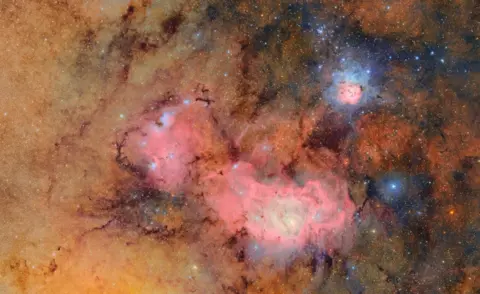 NSF-DOE Vera C. Rubin Observatory
NSF-DOE Vera C. Rubin ObservatoryA robust new telescope in Chile has launched its first pictures, displaying off its unprecedented means to see into the darkish depths of the universe.
In a single image, huge vibrant gasoline and mud clouds swirl in a star-forming area 9,000 mild years from Earth.
The Vera C Rubin observatory, dwelling to the world’s strongest digital digital camera, guarantees to remodel our understanding of the universe.
If a ninth planet exists in our photo voltaic system, scientists say this telescope would discover it in its first 12 months.
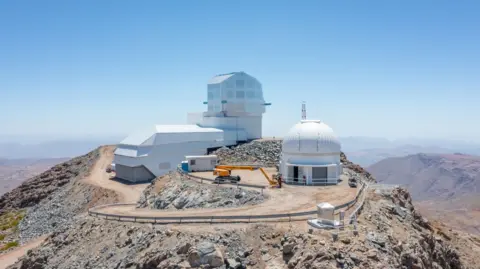 RubinObs
RubinObsIt ought to detect killer asteroids in hanging distance of Earth and map the Milky Manner. It should additionally reply essential questions on darkish matter, the mysterious substance that makes up most of our universe.
This once-in-a-generation second for astronomy is the beginning of a steady 10-year filming of the southern evening sky.
“I personally have been working in direction of this level for about 25 years. For many years we needed to construct this phenomenal facility and to do one of these survey,” says Professor Catherine Heymans, Astronomer Royal for Scotland.
The UK is a key associate within the survey and can host information centres to course of the extraordinarily detailed snapshots because the telescope sweeps the skies capturing every little thing in its path.
Vera Rubin might improve the variety of identified objects in our photo voltaic system tenfold.
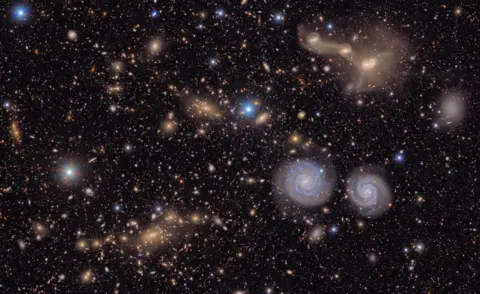 NSF-DOE Vera C. Rubin Observatory
NSF-DOE Vera C. Rubin ObservatoryBBC Information visited the Vera Rubin observatory earlier than the discharge of the pictures.
It sits on Cerro Pachón, a mountain within the Chilean Andes that hosts a number of observatories on non-public land devoted to house analysis.
Very excessive, very dry, and really darkish. It’s a good location to observe the celebs.
Sustaining this darkness is sacrosanct. The bus journey up and down the windy street at evening have to be performed cautiously, as a result of full-beam headlights should not be used.
The within of the observatory isn’t any completely different.
There’s a entire engineering unit devoted to creating certain the dome surrounding the telescope, which opens to the evening sky, is darkish – turning off rogue LEDs or different stray lights that would intervene with the astronomical mild they’re capturing from the evening sky.
The starlight is “sufficient” to navigate, commissioning scientist Elana Urbach explains.
One of many observatory’s large targets, she provides, is to “perceive the historical past of the Universe” which suggests with the ability to see faint galaxies or supernova explosions that occurred “billions of years in the past”.
“So, we actually want very sharp pictures,” Elana says.
Every element of the observatory’s design reveals comparable precision.
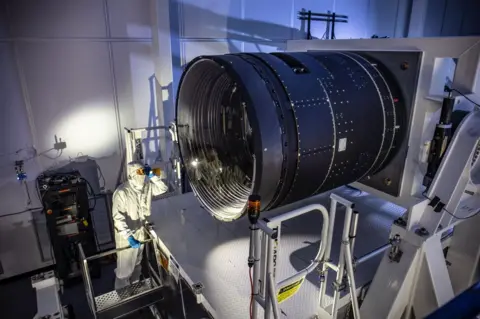 SLAC Nationwide Accelerator Laboratory
SLAC Nationwide Accelerator LaboratoryIt achieves this by its distinctive three-mirror design. Gentle enters the telescope from the evening sky, hits the first mirror (8.4m diameter), is mirrored onto the secondary mirror (3.4m) again onto a 3rd mirror (4.8m) earlier than coming into its digital camera.
The mirrors have to be saved in impeccable situation. Even a speck of mud might alter the picture high quality.
The excessive reflectivity and pace of this permit the telescope to seize quite a lot of mild which Guillem Megias, an energetic optics skilled on the observatory, says is “actually vital” to look at issues from “actually distant which, in astronomy, means they arrive from earlier instances”.
The digital camera contained in the telescope will repeatedly seize the evening sky for ten years, each three days, for a Legacy Survey of Area and Time.
At 1.65m x 3m, it weighs 2,800kg and offers a large area of view.
It should seize a picture roughly each 40 seconds, for about 8-12 hours an evening because of speedy repositioning of the shifting dome and telescope mount.
It has 3,200 megapixels (67 instances greater than an iPhone 16 Professional digital camera), making it so high-resolution that it might seize a golf ball on the Moon and would require 400 Extremely HD TV screens to point out a single picture.
“After we received the primary picture up right here, it was a particular second,” Mr Megias stated.
“After I first began working with this challenge, I met somebody who had been engaged on it since 1996. I used to be born in 1997. It makes you realise that is an endeavour of a technology of astronomers.”
It will likely be right down to a whole lot of scientists world wide to analyse the stream of information alerts, which can peak at round 10 million an evening.
The survey will work on 4 areas: mapping adjustments within the skies or transient objects, the formation of the Milky Manner, mapping the Photo voltaic System, and understanding darkish matter or how the universe fashioned.
However its largest energy lies in its fidelity. It should survey the identical areas over and over, and each time it detects a change, it’ll alert scientists.
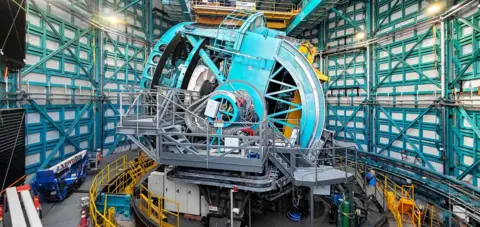 RubinObs
RubinObs“This transient aspect is the actually new distinctive factor… That has the potential to point out us one thing that we hadn’t even thought of earlier than,” explains Prof Heymens.
Nevertheless it might additionally assist shield us by detecting harmful objects that out of the blue stray close to Earth, together with asteroids like YR4 that scientists briefly fearful early this 12 months was on monitor to smash into our planet.
The digital camera’s very massive mirrors will assist scientists detect the faintest of sunshine and distortions emitted from these objects and monitor them as they pace by house.
“It is transformative. It is going be the biggest information set we have ever had to have a look at our galaxy with. It should gasoline what we do for a lot of, a few years,” says Professor Alis Deason at Durham college.
She’s going to obtain the pictures to analyse how far again the celebs attain within the Milky Manner.
In the meanwhile most information from the celebs goes again about 163,000 mild years, however Vera Rubin might see again to 1.2 million light-years.
Prof Deason additionally expects to see into the Milky Manner’s stellar halo, or its graveyard of stars destroyed over time, in addition to small satellite tv for pc galaxies which are nonetheless surviving however are extremely faint and arduous to seek out.
Tantalisingly, Vera Rubin is considered highly effective sufficient to lastly resolve a long-standing thriller concerning the existence of our photo voltaic system’s Planet 9.
That object could possibly be as distant as 700 instances the space between the Earth and the Solar, far past the attain of different floor telescopes.
“It is gonna take us a very long time to essentially perceive how this new stunning observatory works. However I’m so prepared for it,” says Professor Heymans.

Get our flagship publication with all of the headlines it’s good to begin the day. Sign up here.



